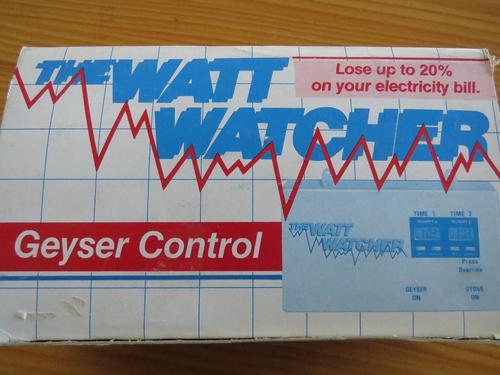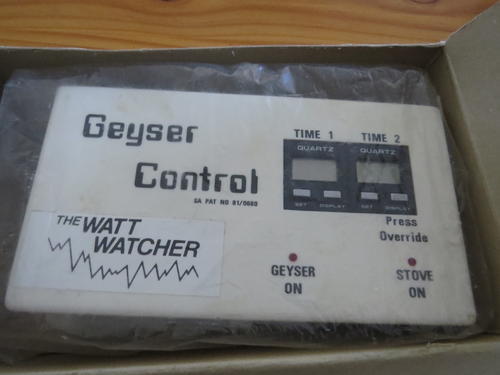The Watt Watcher Geyser Control...SAVE THOUSANDS ON ELECTRICITY!
Check my rate
| Main centres: | 1-3 business days |
| Regional areas: | 3-4 business days |
| Remote areas: | 3-5 business days |
Product information
Are automatic timers on geysers efficient?
Simple Numerical Analysis to establish Energy Saving Guidelines
T. C. Verster
The rapidly rising cost of electricity is a high profile issue and many householders are willing to take action (or are already doing so) to manage their own consumption, but do not have enough factual information to choose the best plan of action for themselves.
The purpose of this article is to provide information on the use of automatic timers to switch the electric geyser on and off for certain periods and how this affects the efficiency and/or wastefulness of hot water production. More and more timers are being installed, and many of them have no or little beneficial effect, due to misconceptions about the thermal behaviour of the geyser. On the other hand, many consumers decide not to install timers, also due to false assumptions. If applied intelligently, timers could play a major role in minimising hot water energy cost.
Choice of Timers:
Either an electronic (digital) timer or an electro-mechanical timer can be used to control a geyser, the main requirements being:
� Ability to maintain real time during power off periods, e.g. it must contain a small backup battery to keep the electronic clock or electro-mechanical motor running.
� Specification to switch the required amperage (e.g. 17 A for a 4 KW element).
Case study of using a timer
One very prevalent false assumption about timers that has to be dismissed at the beginning, is that randomly chosen short geyser switch-off periods (few hours each) during the day will save significant energy. The important principle to follow in setting a timer for energy-saving purposes, is to try and duplicate the use of an electric kettle: heat up enough water for your immediate need (a cup of tea) and refill it with cold water without reheating it, until just before you need another cup of tea, maybe a few hours or a day later.

A single person, a couple or a small family can choose to bath or shower within a short time span (06:00 � 7:00, say) every day. The timer should then be set to start heating the water at 04:00 and switch off at 06:00, so that the occupants have hot water (60 C, say) for a bath and shower, say, using 100 L of mixed water at 45 C. The inflow of cold water at 15 C will start mixing with the remaining hot water in the geyser, and attain a value of 40 C, which will very slowly have cooled down to 35 C by the time the timer switches on the next morning at 04:00 (Fig. 1 shows one such 24 hour cycle). For 22 hours no reheating takes place, and the lukewarm contents lose much less energy, than if the geyser had been kept at 60 C all the time. The graphs in Fig. 2 clearly illustrate this.

It is evident that use of a timer in this example diminishes the monthly energy account from 196 KWh to 136 KWh, for the same amount of hot water used per day. The productive energy to produce 100 L of bath water at 45 C every day is 105 Kwh/mo, which shows that the energy wasted in keeping the 150 L geyser permanently at 60 C, is 91 Kwh/mo, while only 31 Kwh/mo is lost when a timer is used as described above; this translates into a reduction of 66 % in wasted energy.
A final question to settle is: what happens to the saving of 66 % (Fig. 2) if the 100 L hot water usage does not take place all at once, but a 50 L bath early in the morning and another 50 L bath 12 hours later, and the timer being reset to preheat water twice a day? The result is that the middle curve in Fig. 2 moves up to a less efficient position (37% saving). The reason is that if a smaller proportion of the hot water in the geyser is withdrawn, a smaller amount of cold water enters and the resultant mix is at a temperature not much below the thermostat setting. Therefore higher heat losses occur during the subsequent hours when nothing further happens.
Thus, only if the demand far exceeds supply, is it advisable to set the timer for two daily �on� periods, which should be timed such that the �electric kettle� principle is still followed, and not letting the geyser reheat after the rush is over. This is not optimum, but still preferable to the permanently �on� situation without a timer. A high usage of hot water in a household can often also be tempered by installing water saving shower heads and taps, which make a very effective energy saving combination with a geyser timer.
Another useful fact which is relevant at this point: Eskom's request to consumers to switch off their geysers during the early morning and late afternoon peak demand periods, is to protect their supply reserve margin. If the consumer tries to comply blindly, he will do his civic duty, but will not necessarily make any significant reduction in his monthly account. It is often possible, however, to work out his own energy saving strategy first and subsequently accommodate the two no-go time periods into his timer settings.

